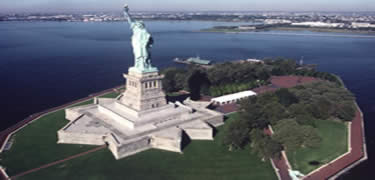The Statue Of Liberty
"Give me your tired, your poor,
Your huddled masses yearning to breathe free,
The wretched refuse of your teeming shore.
Send these, the homeless, tempest-tossed to me.
I lift my lamp beside the golden door."
Sculptor Frederic Auguste Bartholdi was commissioned to
design a sculpture with the year 1876 in mind for completion,
to commemorate the centennial of the American
Declaration of Independence.
The Statue was a joint effort between America and France
and it was agreed upon that the American people were to
build the pedestal, and the French people were responsible
for the Statue and its assembly here in the United States.
However, lack of funds was a problem on both sides
of the Atlantic Ocean.
In France, public fees, various forms of entertainment, and
a lottery were among the methods used to raise funds. In
the United States, benefit theatrical events, art exhibitions,
auctions and prize fights assisted in providing needed funds.
Meanwhile in France, Bartholdi required the assistance of
an engineer to address structural issues associated with
designing such as colossal copper sculpture.
Alexandre Gustave Eiffel (designer of the Eiffel Tower)
was commissioned to design the massive iron pylon and
secondary skeletal framework which allows the Statue's copper
skin to move independently yet stand upright.
Back in America, fund raising for the pedestal was going
particularly slowly, so Joseph Pulitzer (noted for the Pulitzer
Prize) opened up the editorial pages of his newspaper,
"The World" to support the fund raising effort. Pulitzer used
his newspaper to criticize both the rich who had failed to
finance the pedestal construction and the middle class who
were content to rely upon the wealthy to provide the funds.
Pulitzer's campaign of harsh criticism was successful in
motivating the people of America to donate.

Financing for the pedestal was completed in August 1885,
and pedestal construction was finished in April of 1886.
The Statue was completed in France in July, 1884 and
arrived in New York Harbor in June of 1885 on board
the French frigate "Isere" which transported the Statue
of Liberty from France to the United States. In transit, the
Statue was reduced to 350 individual pieces and packed in
214 crates. The Statue was re-assembled on her new
pedestal in four months time. On October 28th 1886, the
dedication of the Statue of Liberty took place in front of
thousands of spectators. She was a centennial gift ten years late.
The story of the Statue of Liberty and her island has been one
of change. The Statue was placed upon a granite pedestal
inside the courtyard of the star-shaped walls of Fort Wood.
The United States Lighthouse Board had responsibility for
the operation of the Statue of Liberty until 1901. After 1901,
the care and operation of the Statue was placed under the
War Department. A Presidential Proclamation declared
Fort Wood (and the Statue of Liberty within it) a National
Monument on October 15th, 1924 and the monument's
boundary was set at the outer edge of Fort Wood.
In 1933, the care and administration of the National
Monument was transferred to the National Park Service.
On September 7, 1937, jurisdiction was enlarged to
encompass all of Bedloe's Island and in 1956, the island's
name was changed to Liberty Island. On May 11, 1965,
Ellis Island was also transferred to the National Park Service
and became part of the Statue of Liberty National Monument.
In May of 1982, President Ronald Reagan appointed Lee
Iacocca to head up a private sector effort to restore the
Statue of Liberty. Fundraising began for the $87 million
restoration under a public/private partnership between the
National Park Service and the Statue of Liberty-Ellis Island
Foundation, Inc., to date the most successful such partnership
in American history. In 1984, at the start of the Statue's
restoration, the United Nations designated the Statue of
Liberty as a World Heritage Site. On July 5, 1986 the newly
restored Statue re-opened to the public during Liberty
Weekend, which celebrated her centennial.

Visitors climb 354 steps to reach the crown or 192 steps in
order to reach the top of the pedestal. There are 25 windows
in the crown which symbolize gemstones found on the earth
and the heaven's rays shining over the world.
The seven rays of the Statue's crown represent the seven seas
and continents of the world. The tablet which the Statue holds in
her left hand reads (in Roman numerals) "July 4th, 1776."
The total weight of copper in the Statue is 62,000 pounds
(31 tons) and the total weight of steel in the Statue is 250,000
pounds (125 tons). Total weight of the Statue's concrete
foundation is 54 million pounds (27,000 tons). The copper
sheeting of the Statue is 3/32 of an inch thick or 2.37mm.

Height from to of base to torch 151'1" 46.05m
Ground to tip of torch 305'1" 92.99m
Heel to top of head 111'1" 33.86m
Length of hand 16'5" 5.00m
Index finger 8'0" 2.44m
Head from chin to cranium 17'3" 5.26m
Head thickness from ear to ear 10'0" 3.05m
Distance across the eye 2'6" .76m
Length of nose 4'6" 1.37m
Length of right arm 42'0" 12.80m
Thickness of right arm 12'0"
Thickness of waist 35'0"
Width of mouth 3'0"
Length of tablet 23'7"
Width of tablet 13'7"
Thickness of tablet 2'0"
Ground to top of pedestal 154'0"
Date Construction of the Statue began in France: 1875
Title of Statue: "Liberty Enlightening the World"
Sculptor: Auguste Bartholdi
Structural Engineer: Gustave Eiffel
Statue completed in Paris: June 1884
Statue presented to America by the people of France: July 4, 1884
Statue dismantled and shipped to US: Early 1885
1885 Transport Ship: French frigate "Isere"
Number of individual pieces shipped to US: 350
Number of crates required: 214
Location of Statue: Liberty Island, formerly Bedloe's Island
and Fort Wood (fortress for protection of New York Harbor 1811)
Architect of the pedestal: Richard Morris Hunt (in 1877)
Champion Fundraiser for the Pedestal: Joseph Pulitzer,
Treaurer of The American Committee for the Statue of Liberty:
Henry A. Spaulding
Date the cornerstone was laid on Bedloe's Island in New York Harbor:
5 August 1884
Source of Granite for the Pedestal: Leete's Island, Connecticut
Date of Final Assembly of statue & pedestal: 1886
Official accepting Statue on behalf of US: President Grover ClevelandDate of Acceptance by President: October 28, 1886
Date designated a National Monument: October 15, 1924
Wind speed at which Statue sways 3 inches (7.62 cm): 50 mph
Torch sway in 50 mph wind: 5 inches (12.7 cm).
Number of windows in the crown: 25
Number of spikes in the crown: 7
Inscription on tablet: "July 4, 1776" (in Roman numerals)
Back To Famous Places & Events
Free Pet Newsletter
Search Our Site
Pet Care Tips Directory
Gift Items for All Pet Lovers
Stuffed Plush Animals
Canine Care Tips
Feline Care Tips
Horse Care Tips
Site Map
Copyright ©
Choose To Prosper
